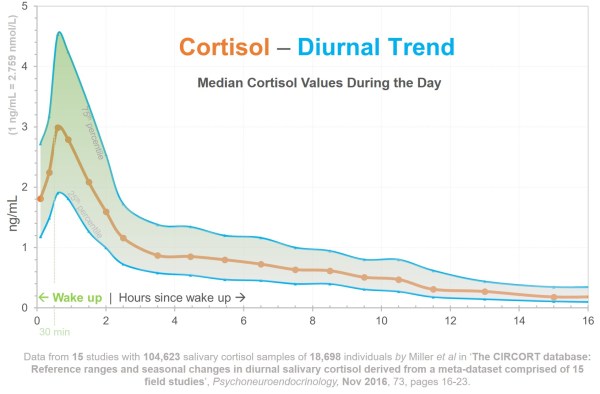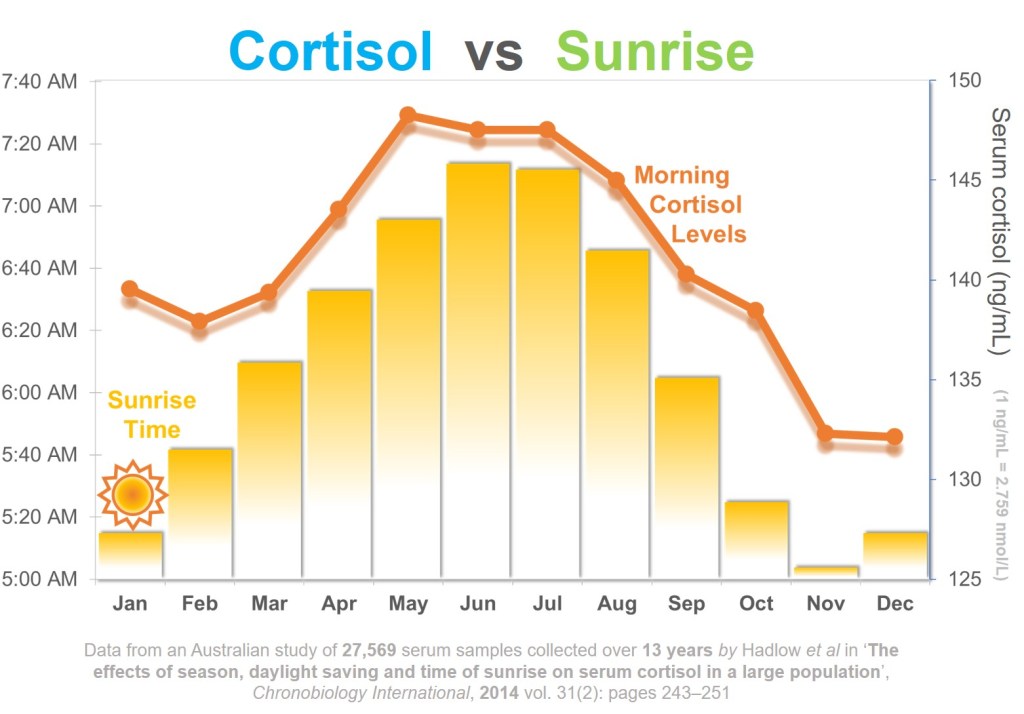
Cortisol levels change throughout the day. But they change a lot within first hour of waking up.
This dramatic rise and subsequent drop in the morning is called Cortisol Awakening Response (CAR).
It is a relatively new finding. Jens Pruessner and Clemens Kirschbaum first systematically reported this trend in 1997.

Figure 1: The daily or diurnal trend of cortisol stress hormone. (Source: The CIRCOT Database)
To capture the cortisol variation during the day, a 4-point diurnal cortisol test measures cortisol levels from four different times of the day to assess the daily trend. This requires collecting four saliva samples within 24 hours.
The first sample collection is around 30 minutes after waking up. This is the time when levels are highest and change quickly.
The sketch on top of this page shows the quick change in morning levels. Ideally, several samples should be collected early in the morning to precisely know the peak, but that might be practically difficult and expensive.
Therefore, it is extremely important to ensure proper protocol is followed in sample collection for best results. It helps to know the trend of morning cortisol variation and the factors affecting it.
The early morning cortisol is affected by several factors:
The exact time of collection after waking up—levels are flat for first 15 minutes but then quickly change in next 30 to 60 minutes.
Darkness or dim light or full exposure to sunlight after waking up—the peak levels are higher with more light.
Season of the year—which again correlates to the amount of light; late sunrise time (in winter) gives higher levels in morning according to an Australian study.

Figure 2: The effect of season, daylight saving, and time of sunrise on cortisol, from an Australian study. Note that June-July is winter time in southern hemisphere and higher morning levels follow the late sunrise. (Source: T&D Online)
Although day of the week, or weekends, have no serious impact on morning levels, the amount of light and other motivational factors might complicate the collection time.
That's why one should carefully monitor the waking hours between a weekday and weekends, while testing.
It's best to temporarily avoid—or further delay—the collection of morning samples during these conditions:
Current illness—e.g., flu, fever, or common cold can affect results, it's best to postpone until full recovery (Adam and Kumari, 2009).
Estimated ovulation—it's best to avoid sample collection during this time (around two days before and after) (Wolfram, 2011).
Jet lag—can have an effect up to 7 days (Doane., 2010).
Night time working hours can shift the diurnal (daily) cycle. This impact can last up to a week after any changes in working hours (Griefahn and Robens, 2010; Harris et al., 2010).
Several other factors modulate morning cortisol levels and deserve careful consideration, as confirmed by a 2022 expert review:
Gender—women show much stronger peaks than men (Pruessner, 1997).
Age—certain age groups, especially during growth and development—e.g., in infants or at the onset of puberty in girls, and among elderly— hormone levels may show variations (Bäumler, 2013; Oskis, 2009; Evans 2013).
Oral contraceptives (Bouma, 2009; Pruessner, 1997; Wüst, 2000b).
Habitual smoking (Badrick, 2007).
Heavy drinking (Badrick, 2008).
Morning peak variations also correlate with lower income, education levels, and mildly with ethnicity (Golden, 2014; Hajat, 2010).
Good mental health and social support improve accuracy (DiMatteo, 2004; DiMatteo, 2000).
Obesity, body-mass-index, or hip-to-waist ratio (Steptoe, 2004; Therrien, 2007).
Medication and endocrine disorders, e.g., Cushing or Addison’s syndromes can dramatically affect the measurements (Granger, 2009). Some medicines used for mental health, such as antipsychotics, antidepressants, and stimulants are known to affect cortisol levels (Subramaniam, 2019).
Pregnancy has significant biological changes that might show surprisingly high cortisol peaks (De Weerth and Buitelaar, 2005).
Injury to the head might affect the pituitary gland adding more variables (Buchanan, 2004; Wolf, 2005).
No significant effect of psychological factors (e.g., fear of public speaking) in morning cortisol levels. However, they might have an effect in afternoon or night (Chida and Steptoe, 2009).
Most of these factors affecting morning cortisol do not appreciably affect levels later in the day.

Figure 3: Cortisol levels increase with age for both men and women. (Source: Pruessner 1997)
Research shows inaccurate reporting of morning cortisol collection time is more common than realized. The recorded time is often late, and can impact the results.
Careful monitoring of actual wake up time versus self-reported time showed 1 in 5 people actually woke up earlier than what they had reported. This could be anywhere between 5 mins to 30 mins. For 1 in 7 people, this gap was over 30 minutes.
However, any difference over 15 minutes can cause significant variation in results.
Difference of 5 to 10 minutes at the beginning, right after breaking the sleep is likely not critical, since the rise in cortisol levels few minutes after waking up is still small.
But anything after first 15 minutes starts to have an impact due to steep rise in the levels at this time.
Researchers have identified multiple reasons why people collect their morning samples later than expected:
Avoiding the discomfort of collection.
Might need to prioritize other responsibilities.
Sleep inertia, being half-asleep without being fully mentally awake and no body movement. That makes it difficult to identify exact time of waking up, despite well-intentioned efforts.
One simple way to motivate people is by clearly stating that collection time will objectively affect their results.
It also helps if they know their morning sample is one of the most important measurement, and accurate documentation of this particular sample is crucial. Having a normal routine is useful.
Other methods include:
Using a diary that logs time of waking up and collection. Keeping the kit next to bed, with a pen to note down the time has been found helpful.
Using an alarm to wake up—research shows the cortisol spike in morning is unaffected by whatever method is used to wake up.
Use of smart phone to track time—taking a picture at collection will add a time stamp to validate the time later on. However, the waking up time still needs to be monitored.
Heart beat monitors—when tied to the chest they can accurately provide waking up time. Heart beat increases once you are awake.
Other techniques include sample collection in a sleep lab, automated blood collection, wrist actigraphy, or polysomnography—however, all these methods are either expensive or do not represent natural setting.
Although, how you wake up seems to have no impact on the results (Stalder, 2009; Wüst, 2000b), what you do next is important.
What it means to be awake: When you are awake, i.e., you are conscious: you know who and where you are; you are in a state that is clearly different from when you were sleeping even though you may still feel tired.
Avoiding premature awakening: If you wake up in the night and plan to go back to sleep, do not begin sampling; collect only when you are awake for the final time before you plan to get up for the day.
Refraining from dozing off: During this measurement, do not go back to sleep or ‘doze off’ after your initial awakening. You can stay in the bed or get out of the bed but it's best to stay awake (even if you are not fully alert) during and after the saliva sampling period.
Except water, eating or drinking anything else might affect the results. Here are few recommendation.
No Coffee—as caffeine is known to affect cortisol levels (Kudielka, 2009).
No Smoking—as nicotine may interfere with the results.(Kudielka, 2009).
No breakfast, especially, sugary and high protein foods, e.g., eggs; in general, food and blood glucose levels can modulate cortisol levels (Gibson, 1999; Rosmond, 2000, Rohleder and Kirschbaum, 2007).
No physical exercise, as cortisol levels might change with vigorous exercise beyond a certain level (Hill, 2008; Kirschbaum and Hellhammer, 1994).
To lie down or move around for normal activities as they don’t show any impact (Hucklebridge, 2002; Wilhelm, 2007).
Brushing teeth, is not known to have any significant effect on morning cortisol levels (Gröschl, 2001). However, for vigorous brushing–that might result in bleeding–the impact of this blood in the saliva is not so clear (Kivlighan, 2004).
The duration and quality of sleep—impact is unclear but recommendation is to follow normal routine.
Mental health—there is some data indicating morning levels maybe influenced by previous day's events, especially any negative experiences (of loneliness, threat, lack of control, etc.). Steep rise in morning levels is seen if there is a challenging and demanding day ahead (Adam, 2006; Fries, 2009; Wilhelm, 2007). In that sense, morning levels are an indication of the day ahead.
Although labs accept samples up to several weeks, for best results, one should immediately mail the saliva samples. In case of delay, store them in the refrigerator until you are ready to ship.

Order an at-home Cortisol Test kit.
Our tests do not substitute the advice of a trained physician or health professional. Please do not use the results for diagnosing or treating any health problems. We encourage you to share the results with your primary care physician before making any decision based on the test results.
Also available: Thyroid test, Inflammation and Vitamin D test, Comprehensive food sensitivity test, Celiac genetic test, Pre-Alzheimer’s APOE genetic test, Cholesterol and Heart Health Test, Pre-diabetic A1c Test, Gut health test and H. pylori test, cortisol saliva test, sleep and stress test, at-home metabolism test, women’s health test, men’s health test, at-home testosterone test, and many more health test options.